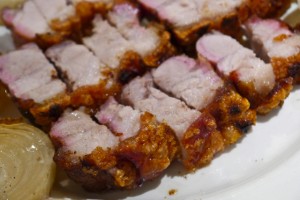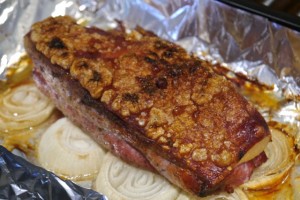Chinese Roast Pork (烧肉)
This is a re-post of the original, which I put up in February 2007, updated with new details on my experience roasting pork in a rented apartment in London 🙂 New details are in italics.
This is not exactly Mum’s recipe, however, it was Mum’s constant strive for crispy roast pork (Chinese style) perfection that made me look out for such a recipe. The original was published on 27 July 2003 in Singapore’s Sunday Times in the “Mad About Food” column by Sylvia Tan. I have tried the recipe numerous times, and it works great! So much so that I’ve given up trying the run-of-the-mill roast pork that they sell in the food centres / food court… and the ones which are supposedly professionally-roasted, from Chinese restaurants in Leicester Square in London 😛
Ingredients (served 3-4 people):
1 kg pork belly, uncut
1 Tbs salt
2 Tsp pepper
2 Tsp five spice powder
Vegetable oil
(ingredients can be halved if you are cooking for less people)
Method
Fry (without oil) the salt, pepper and five spice power in a wok for a few minutes. Rub this salt-seasoning mixture into the meat and leave uncovered in the fridge overnight. This effective dries out the skin to ensure that the roast pork ends up crispy and crunchy.
Before roasting, score the rind (skin) of the pork and rub oil all over it. Pre-heat oven to 200 deg C. Then place the pork, skin upwards into the oven either on a rack, or on thick slices of onions such that the hot air can circulate all over it.
Roast for ten minutes on 200 deg C. Then turn the heat down to 160 deg C and roast for the next hour.
Turn up the heat to 250 deg C next and roast for 15 mins (or till you hear crackling) at the end to ensure a crunchy finish.
Remove pork from oven. Let it cool for half and hour and then slice for serving. For extra flavouring, dip the slices of crunchy roast pot into sweet soya sauce.
When I tried to do the above recipe in my rented apartment in London, I realise to my dismay that the built-in cooker in the apartment had a gas oven rather than the electric one that I am used to previously). Instead of temperature settings, it came with “gas-mark” settings and the instruction manual for the oven didn’t state the temperatures for each gas-mark setting.
Not to be daunted, I invested in a cheap oven thermometer and did a test (without cooking any meat). The maximum temperature that the oven could reach was only about 190 degree Celsius.
I decided to experiment by changing the steps to initially roasting the pork at a maximum temperature of 190 degrees Celsius (gas-mark 9) for 10 minutes, then turning down the setting to 7.5 to 8 for the next hour. I found that at 7.5 to 8, I managed to get approximately 160 degrees Celsius. The pork turned out looking nice after one hour was up, but I had to solve the problem of achieving 250 degrees Celsius to make the skin crackle. I tried 15 minutes at gas-mark 9, but that took me back to only 190 degrees Celsius without crackling the skin.
Thankfully, the original recipe gave me an idea on how to solve this. I transferred the pork to the oven grill compartment and grilled the pork at the highest setting. All it took was less than a minute, and blisters started to form on the skin, causing it to crackle. That was an indication to me that I had been successful… the results turned out to be deliciously crackling! 🙂


| No Comments »